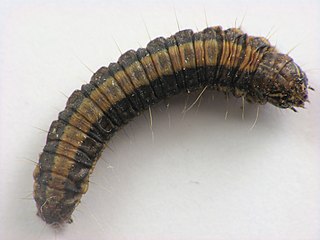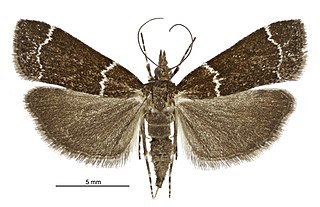
Pyraustinae is a large subfamily of the lepidopteran family Crambidae, the crambid snout moths. It currently includes over 1,400 species, the majority of them tropical but some found in temperate regions including both North America and Europe.

Spilomelinae is a very species-rich subfamily of the lepidopteran family Crambidae, the crambid snout moths. With 4,132 described species in 340 genera worldwide, it is the most speciose group among pyraloids.

Delexocha is a monotypic moth genus in the family Oecophoridae erected by Ian Francis Bell Common in 1997. Its only species, Delexocha ochrocausta, was first described by Edward Meyrick in 1884. It is found in Australian in Queensland, New South Wales, the Australian Capital Territory and Victoria.

Deuterarcha is a genus of moths of the family Crambidae. The genus was described by Edward Meyrick in 1884.

Metasia is a genus of moths of the family Crambidae.
Myriostephes is a genus of moths of the family Crambidae. The genus was erected by Edward Meyrick in 1884.

Notarcha is a genus of moths of the family Crambidae described by Edward Meyrick in 1884.

Orocrambus is a genus of moths of the family Crambidae. All species are endemic to New Zealand.
Piletocera is a genus of moths of the family Crambidae. The genus was first described by Julius Lederer in 1863.

Austrocidaria parora is a species of moth of the family Geometridae. It is endemic to New Zealand.

Borkhausenia is a genus of the concealer moth family (Oecophoridae) described by Jacob Hübner in 1825. Among these, it belongs to subfamily Oecophorinae, wherein it is probably closely related to Hofmannophila. In the past, several other Oecophoridae have been included in Borkhausenia, as well as a few even more distant members of the superfamily Gelechioidea. Metalampra was originally described as a subgenus of Borkhausenia. Telechrysis has also been included here as a subgenus by some, while other authors have considered it a separate genus in the Oecophorinae or – if these are also considered distinct – the Amphisbatinae.

Izatha is a genus of moths of the family Oecophoridae. They are commonly known as lichen tuft moths. This genus is endemic to New Zealand.

The Epipaschiinae are a subfamily of snout moths. Almost 600 species are known today, which are found mainly in the tropics and subtropics. Some occur in temperate regions, but the subfamily is apparently completely absent from Europe, at least as native species. A few Epipaschiinae are crop pests that may occasionally become economically significant.

Astrapometis is a monotypic snout moth genus described by Edward Meyrick in 1884. It contains the species Astrapometis saburalis described by Francis Walker in 1859. It is found in Australia.

Cardamyla is a genus of snout moths. It was described by Francis Walker in 1859 and is known from Australia.
Musotiminae is a subfamily of the lepidopteran family Crambidae. It was described by Edward Meyrick in 1884

Antiscopa acompa is a moth in the family Crambidae. It was described by Edward Meyrick in 1884 from specimens obtained near Lake Wakatipu at 1,200 feet. It is endemic to New Zealand.

Antiscopa epicomia is a moth in the family Crambidae. It was described by Edward Meyrick in 1884 from specimens obtained near Arthur's Pass and Dunedin. It is endemic to New Zealand.

Eudonia leptalea is a moth in the family Crambidae. This species is endemic to New Zealand, including the Chatham Islands.

Eudonia leucogramma is a moth in the family Crambidae. This species was first described by Edward Meyrick in 1884. It is endemic to New Zealand.

















